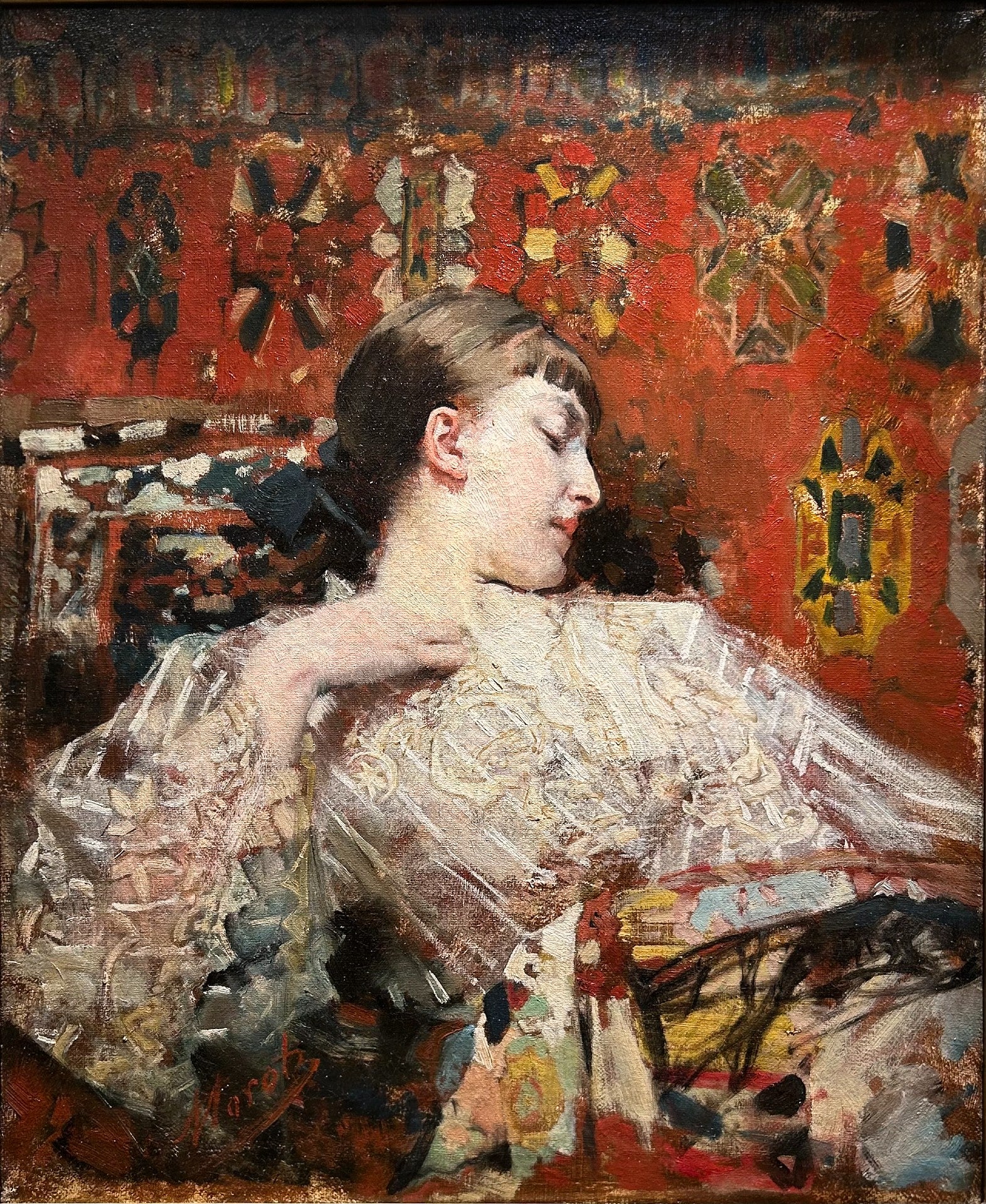

Aime Nicolas Morot
A Well-Earned Rest
Oil on canvas, signed
Image size: 17 3/4 x 14 1/2 inches (45 x 37 cm)
Original gilt frame
The female sitter of this portrait wears a beautifully embroidered white kaftan as she relaxes in a reclined position. She is surrounded by tapestries of reds, blacks and browns, with their patterns being inspired by those of Persian rugs and fabrics. She lounges gracefully, her hand held idly by her collarbone as her head lolls to one side. The orientalist tone of the painting imbues it with a certain decadence - a lady on her travels to far away lands, taking a short rest out of the harsh desert sun.
Morot’s brushwork in this portrait is one that serves to accentuate the textures within the painting. The softness of the lady’s skin is readily apparent; the thicker application of paint on her kaftan depicts the qualities of embroidery; the broad strokes used for the tapestries in the background implies a thickness to their fabric. Additionally, the colour palette is truly masterful, with the pallor of the lady’s skin and the brightness of her white kaftan strongly contrasting with the deep hues of the tapestries in the background, ensuring that the viewer’s eyes remain firmly focused on the resting woman.
Aimé Nicolas Morot
Morot was born in Nancy in 1850 and began his artistic studies at the Ecole Municipal de Dessin et de Peinture at the age of twelve. Whilst studying here, he was a student of Thiéry and Sellier, before moving to the Ecole Nationale Supérieure des Beaux-Arts in Paris. Here, Morot studied under Cabanel, but found his workshop environment detrimental to his artistic production and left to study independently at the Jardin des Plantes, where he developed a keen eye for depicting animals.
In 1873, Morot won the Grand Prix de Rome for his Babylonian Captivity, and won a fellowship that allowed him to travel to Italy and become a resident of the Villa Medici - the French Academy’s branch in Rome. Morot’s first submission to the 1876 Salon de Paris won him a third-class medal, and the following year he won a second-class medal. Morot’s career only went from strength to strength; 1879 marked the year that Morot received a first-class medal in the Salon for his painting Les Ambronnes, and he won the Medal of Honour in the 1880 Salon for his work The Good Samaritan.
Morot returned to Paris in 1880 and married one of the daughters of acclaimed orientalist painter Jean-Leon Gerome. They had a son and a daughter together, and Morot is known to have used his family members as sitters for his works. Humorously, the Morot family house in Paris was also home to a menagerie of exotic animals.
In Paris, Morot worked at the Academie Julian. His contributions to art were recognised in 1883 when he was awarded the title of Chevalier in the Legion d'Honneur, which progressed to the title of Officier in 1901 and Commandeur in 1912. After Gustave Moreau’s death in 1898, Morot took over his studio and students. In 1900, Morot won the Grand Prix of the Paris Exhibition and became a professor at the Ecole Nationale Superieure des Beaux-Arts.
In his role as professor, Morot was a very prominent figure in the Parisian art scene, as demonstrated by his inclusion in Jules-Alexandre Grün’s 1911 painting One Friday at the French Artists’ Salon.
Morot began construction of a house on the Brittany coast in 1910, and lived there until his death in mid 1913. He exhibited at the Salon all the way up until his passing. His body of work is varied, comprising of a mix of military scenes from his time attached to the French Army, society portraits of prominent figures in 19th century France, animal portraits from his expertise with hunting and his time at the Jardin des Plantes, and orientalist paintings inspired by his travels around North Africa and the Middle East.



